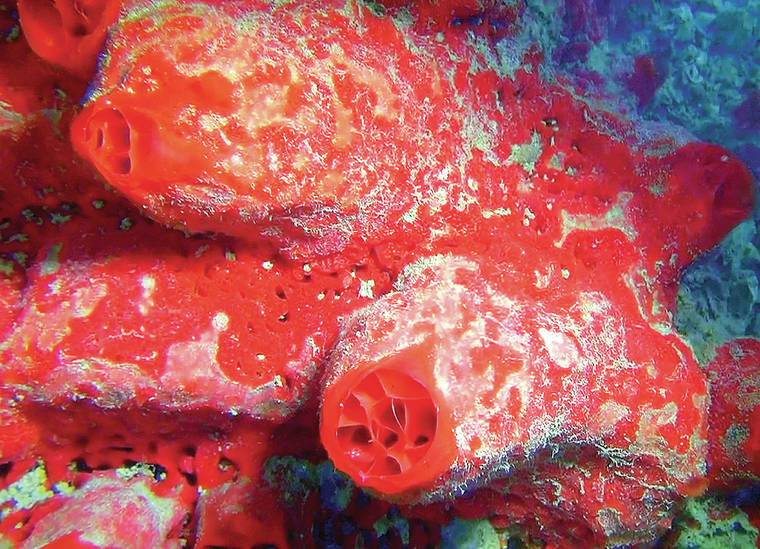Do you know that we have bright-red, underwater volcanoes here in Hawai‘i, and they are very common? They are called the red volcano sponge, and they cover the sea floor on certain reefs, and look like six-inch-tall, mini red volcanoes erupting. It it is quite an amazing sight to see, but you will need an underwater flashlight because these sponges do not like sunlight and live in the shade of caves, piers, jetties or even in old shipwrecks.
Do you know that we have bright-red, underwater volcanoes here in Hawai‘i, and they are very common? They are called the red volcano sponge, and they cover the sea floor on certain reefs, and look like six-inch-tall, mini red volcanoes erupting. It it is quite an amazing sight to see, but you will need an underwater flashlight because these sponges do not like sunlight and live in the shade of caves, piers, jetties or even in old shipwrecks.
Sponges cover the sea floor in almost all oceans around the world, and some species grow up to 10 feet tall.
You might remember your grandmother talking about cleaning her kitchen with a real sponge. The original sponge used by people was a dried, cut piece of a large sea sponge, and still in more-remote parts of the earth people still harvest sea sponges to be used in their homes.
Sponges clean the sea water, so they are an important part of the reef ecosystem. They are living filters, with no mouth, stomach, gills or organs.
They simply draw water in through small pores, filter the water to remove small particles and algae then expel clean, filtered water back into the sea. Kind of like an air purifier you may have in your home.
At one time biologists thought that sponges were some type of aquatic plant, until they studied them in the lab and realized that they are made of many different types of cells that all operate on their own so they do not have a need for organs like most other living animals.
Sponges are known to be able to live in highly polluted bays where they will even remove dangerous toxins from the sea water at a rate faster then any known living creature. Sponges are being studied in the lab because they not only remove toxins from sea water but the toxins do not seem to harm the sponges. They just may give us people some secrets we can use to help clean up our polluted bays and harbors.
When you snorkel or dive you see sponges all the time growing in the shady parts of the coral reef, and especially under piers or lining small caves.
Sponges get their bright colors from minerals in the sea water, and they can be green, pink, yellow, orange, red, black, and even bright blue. It is truly amazing to be diving and go into a dark cave, then turn on your dive lights and see the entire wall of the cave erupt in beautiful colors all mixed together.
You can see dozens of different, multi-colored species up on the underwater educational website, underwater2web.com, in the species identification link.
•••
Terry Lilley, a marine biologist, lives in Hanalei. His websites include underwater-2web.com and www.gofundme.com/5urrm4zw.


